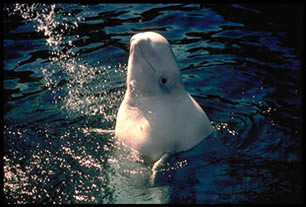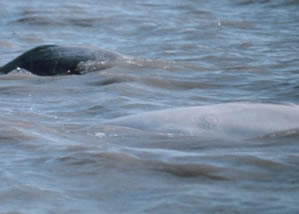
 |
Alaska's Beluga Whales In DeclineApril 16, 2007Courtesy of Far North Science One of the world's most depleted population of whales will get another breather from hunting.  Source: USGS Source: USGS
But what will help Alaska's most urban whales rebound? No one knows. With the genetically isolated beluga whales of Cook Inlet continuing to slide for unknown reasons - and federal biologists within days of announcing whether the whales deserve protection under the Endangered Species Act - Alaska Natives from a local village have agreed to forgo a summer harvest of two whales. The decision comes on the eve of the April 20 deadline, when NOAA Fisheries must say whether the depleted Cook Inlet belugas should be protected as endangered under federal law. Such a decision would jolt Alaska's urban and commercial center by forcing federal agencies to scrutinize Anchorage-area industry and shoreline development for impacts on belugas - including a proposal to spend $600 million or more to bridge Knik Arm, where the whales spend more and more time. This week, leaders in Tyonek, a Denaina Athabascan village on the west side of Cook Inlet across from Alaska's population centers, voluntarily said they would not kill two whales in a July hunt allowed under an agreement with the National Marine Fisheries Service, said Kaja Brix, chief of protected resources in Alaska.  A beluga mother whale and her gray calf in Cook Inlet. A beluga mother whale and her gray calf in Cook Inlet.Janice Waite, NOAA's Ark Collection. "NOAA Fisheries recognizes the importance of Cook Inlet beluga subsistence harvests to Alaska Natives, and have strongly advocated these traditional hunts," Brix said in a release on April 17. "Unfortunately, even subsistence harvests must take a back seat to the need to recover depleted marine mammal stocks, especially those which have been severely reduced in numbers, such as these whales." Numbering at least 1,300 animals in the 1980s, the white adults and gray adolescent beluga whales once roamed Cook Inlet in pursuit of salmon and hooligan, from the treacherous tidal flats near Anchorage to the broad oceanic bays near Homer and the Katmai coast. Then the population - genetically isolated from other Alaska belugas since the end of the Ice Age - crashed by more than 50 percent during the 1990s in a drop biologists blamed on almost entirely on unregulated overhunting by Alaska Natives. The agency began restricting the hunt, and a proposal to list the whales as threatened or endangered was rejected as unnecessary. But in lawsuits and public forums, conservationists and certain Native groups argued that blaming Native hunting was unfair and would not save the whales. Other factors needed to be examined in depth: shipping, industrial noise, commercial fishing, pollution from oil production platforms, sewage discharges from Anchorage and other Cook Inlet communities, changes in fish abundance.
By 1999 the population was estimated at about 350 whales. With harvest limited to one or two animals per year, and other strict guidelines in place, biologists expected the whales to produce 13 to 20 gray babies per year while losing maybe a dozen whales to strandings and other deaths. Each year, the whales were supposed to slowly increase in number. But the rebound never came. Since 2004, only 25 belugas have been confirmed dead from all causes - less than the dozen whales expected to die per year from natural causes, said beluga management biologist Barbara Mahoney. But no one knows how many whales were born. "We don't have the full answer why the Cook Inlet beluga population is not recovering as anticipated," said Brix in the release. "Hunting has been extremely limited, contaminant loads are comparable or less than other Alaskan and Canadian beluga populations, and the beluga strandings were within the expected range in 2004, 2005 and 2006." Gray beluga calves are almost impossible to see in the Inlet's roiling silty waters. They take about five or six years to mature and turn white. Mahoney said she hoped that a surge in numbers would appear when the grays matured and became easier to see. "I was expecting all the grays born after 1999," she said. "I was expecting that in 2005, we would start seeing more whites, and the population would jump. But the trend is down." Based on aerial surveys in June, 2006, the agency estimated that only about 302 belugas remained in the upper Inlet last year. The results suggest the population has slipped 5.6 percent per year since 1994 and a 4.1 percent per year since 1999.
"The latest population abundance estimates confirm a continuing decline," said Brix in the release. "It will be difficult, if not impossible, to meet the dual goals of maintaining a subsistence harvest for the near term while recovering the population itself." The whales face a 26 percent chance of becoming extinct within 100 years, according to a status review released last winter. "It is likely that the Cook Inlet beluga population will continue to decline or go extinct over the next 300 years unless factors determining its growth and survival are altered in its favor." Mahoney said she would like to compile and analyze the data gathered over the past 10 years, plus investigate the ecology and age structure of the whales. But the federal agency has almost no funding for work beyond a June count. |
|